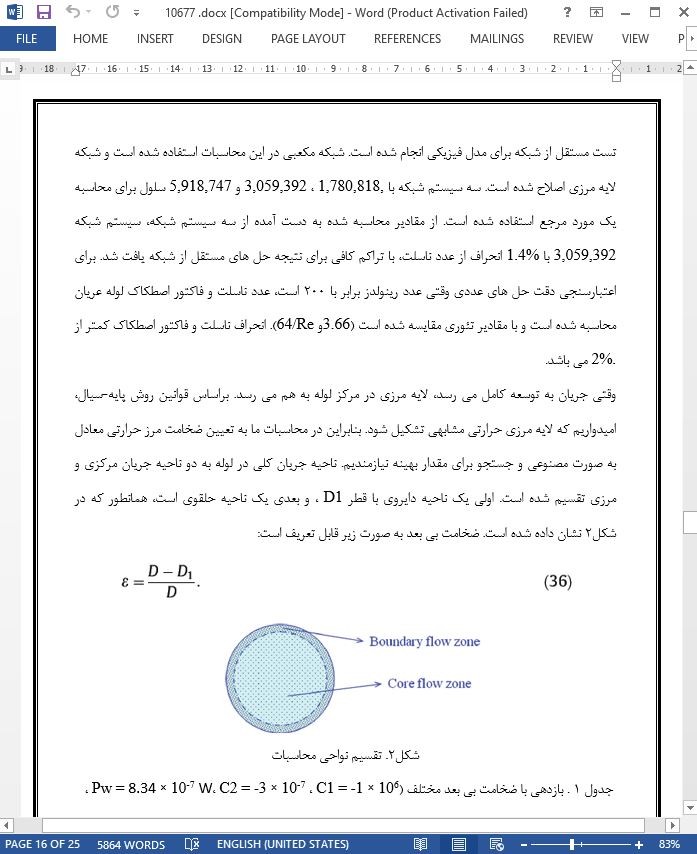
بهینه سازی انتقال گرمای همرفت در یک لوله دایروی بر اساس کمینه سازی تخریب اگزرژی محلی
Abstract
In this study, the equilibrium equation of available potential, which reveals the relation of available potential and local exergy destruction rate, is determined, and the expressions of available potential and local exergy destruction rate are given. To improve heat transfer enhancement and reduce increase amplitude of flow resistance, a method termed as fluid-based heat transfer enhancement is proposed relative to surface-based heat transfer enhancement. An optimal mathematical model by constructing Lagrange function with exergy destruction corresponding to irreversibility loss of heat transfer process and fluid power consumption to flow loss of fluid is adopted to validate this method. To obtain the optimal flow structure in a tube, the tube flow is divided into two parts: core flow and boundary flow. For reducing the irreversibility loss in the core flow, we take fluid exergy destruction as optimization objective with prescribed fluid power consumption. For reducing the flow resistance in the boundary flow, we take fluid power consumption as optimization objective with prescribed fluid exergy destruction. The optimization equations for the convective heat transfer in laminar flow are derived, which are solved numerically. The longitudinal swirling flows in the tube are found at different parameters. In the optimized flow, heat transfer is enhanced greatly while accompanied with a little increase of flow resistance. Comprehensive performance, the ratio of increases in heat transfer and flow resistance, reaches at 3.65 after optimization.
1. Introduction
The enhancement and optimization of heat transfer are essential for energy conservation and environment protection, because heat transfer is related to almost 80% of total energy consumption in industry. Convective heat transfer is one of the common transport processes in industry. It is highly important to develop a theory and corresponding technology for enhancing convective heat transfer. Through numerical simulation and experimental analysis, researchers have developed many technologies to enhance the heat transfer in tube flow. Correspondingly, certain heat-transfer-enhanced tubes are exploited, such as inner-finned tubes [1], spiral corrugated tubes [2], and micro-finned tubes [3]. Bejan et al. [4] divided the tube flow into two parts: boundary flow and core flow. The flow near the wall of tube is defined as boundary flow and the remaining is core flow. In the aforementioned heat-transfer-enhanced tubes, the surfaces in the boundary, which dominate the convective heat transfer between fluid and tube wall, are designed or improved to enhance heat transfer. The mechanism for heat transfer enhancement includes [5]: disturbing the boundary layer, extending the heat transfer surface, and changing the physical properties of the heat transfer surface. Therefore, this kind of method can be designated as surface-based heat transfer enhancement (abbreviated as the surface-based method). This method effectively enhances the convective heat transfer coefficient, but the increase in flow resistance may become significant and the comprehensive performance can be weakened.
5. Conclusions
The equilibrium equation of available potential is obtained, in which the local exergy destruction rate is defined to express the irreversibility loss of the convective heat transfer process. Different from the surface-based heat transfer enhancement method, the fluid-based method is put forward by considering both thermal and flow resistances. The optimal mathematical model is constructed by the two-region method to reflect the principle of fluid-based heat transfer enhancement. By numerically solving the governing equation deduced through functional variation for Lagrange function, the optimal velocity field is obtained. The theoretical analysis is benefit to the high-efficiency and low-resistance heat transfer enhancement technologies. Specific conclusions are summarized as follows. (1) Available potential represents the energy grade of the fluid, and its equilibrium equation expresses the transport process of available energy. By reducing the exergy destruction of the fluid, the irreversibility of transport process can be decreased. (2) An optimization method of convective heat transfer is constructed by setting exergy destruction rate as optimization objective in the core flow and fluid power consumption as optimization objective in the boundary flow in a circular tube, which supports the principle of fluid-based heat transfer enhancement. (3) Numerical results by solving the governing equations show that the optimized flow field in a circular tube is in a structure of longitudinal swirling flows, which shows alternating large and small vortexes in the cross section of tube, and heat transfer can be greatly enhanced with a slight increase in flow resistance.

چکیده
1 . مقدمه
2 . معادله تعادل پتانسیل در دسترس و نرخ تخریب اگزرژی محلی در فرایند انتقال حرارت
3 . روش بهبود انتقال حرارت برپایه سیال
3 . 1 . تشریح روش
3 . 2 . مدل دوهدفه برای اعتبارسنجی روش
4 . تایید عددی جریان آرام در یک لوله
5 . نتایج
Abstract
1. Introduction
2. Equilibrium equation of available potential and local exergy destruction rate in heat transfer process
3. Method of fluid-based heat transfer enhancement
3.1. Description of the method
3.2. Two-objective model for validating the method
4. Numerical verification of laminar flow in a tube
5. Conclusions
- ترجمه فارسی مقاله با فرمت ورد (word) با قابلیت ویرایش، بدون آرم سایت ای ترجمه
- ترجمه فارسی مقاله با فرمت pdf، بدون آرم سایت ای ترجمه
